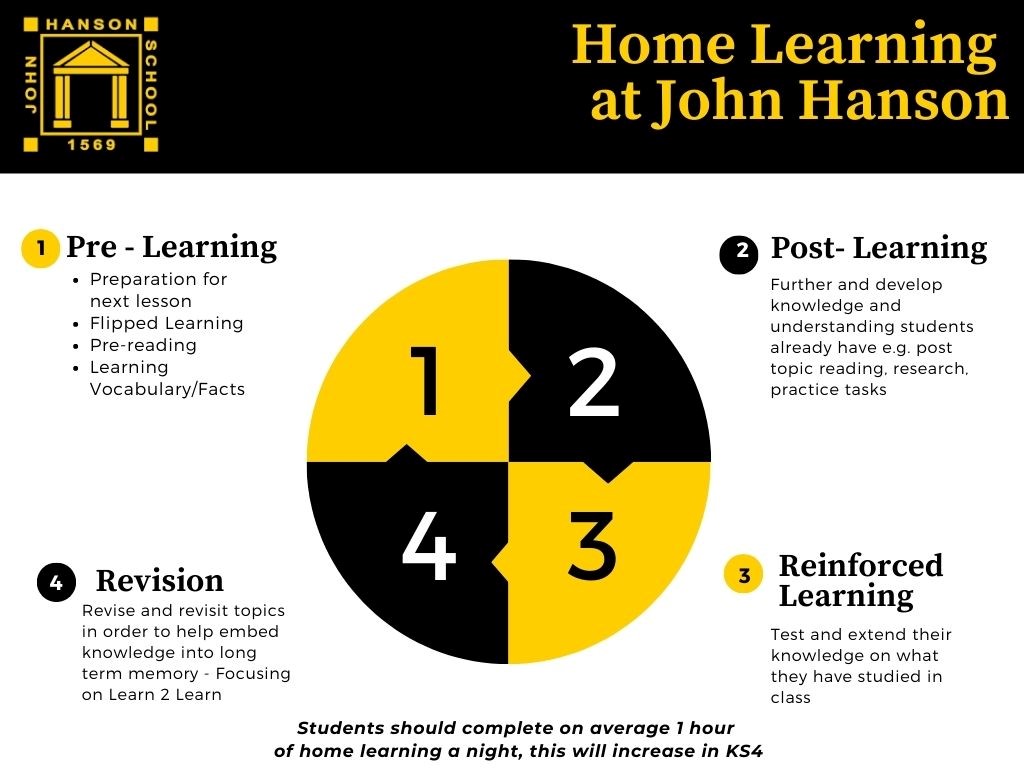Home Learning
Why do we set home learning?
-
Studies have shown that home learning improves the rate of learning by at least 15% (potentially advancing children’s learning by about a year on average).
-
Home learning should bridge the gap between teacher led and student led learning.
-
Home learning provides students with the opportunity to reflect on their learning and practice new skills and knowledge.
-
Home learning is an extension of the learning undertaken in lessons.
-
Home learning develops study habits and independent learning – Learning 2 Learn.
Top Tips for Successful Home Learning
-
If possible have a set time and a place when home learning is to be done. For some young people it will be as soon as they come in from school. Other families will make the time after the evening meal homework time. Having a regular slot helps students keep home learning as a priority and organise their time well.
-
Try and have a quiet place to do home learning, with few distractions. It could be a bed room or a kitchen table.
- The LRC is available to complete home learning before school, after school and at social times.
-
Satchel One will outline what the home learning task is and when it is due in. If students are unsure about the task they should speak to their teacher.
-
Use Satchel One to plan when to do home learning. Teachers should be giving students time to get home learning completed and therefore if you have regular evening events, a sport, youth club, cadets or whatever, it should be possible to build that around the programme.
-
Parents/carers if your child is saying that they have no home learning, do check on Satchel One.
-
Students should expect to spend 15 minutes per hour of teaching on their home learning e.g. if they have computer science twice a fortnight they will be expected to spend 30 minutes on their home learning.
Show my Homework FAQ? s
Q: How do I get to the Satchel One web site?
There is a link to Satchel One at the top of the school website.
Q: What do I do once I get to the Satchel One site?
If you know your username and password, enter the details login. Parents and students both have login details for Satchel One, if you cannot remember these please contact our IT team.
Q: What if I have forgotten or never had a log in?
E-Mail IT Support and they will be happy to send you details it.support@jhanson.hants.sch.uk
Please email the Head of Faculty or individual member of staff should you have any concerns or require clarification about tasks set. Students also log details of tasks in their planners.
Mode A and Mode B
At John Hanson we use the Mode A & Mode B approach to Home Learning. This means that any home learning tasks set should directly link to what students have just covered in lesson or what is coming up in the next lesson, this allows for the learning journey to continue in-between lessons. It also allows opportunities for extended practice and to develop student’s capacity for independent learning. Below is an example of the different types of home learning set.
Mode A: Practice, revision, Pre-Study/Flipped Learning, exam questions, exercises.
Mode B: Research, Open ended projects, creative product making, choices.
Home learning will also always fall into one of the below categories to ensure students a maximising the time.


 WAH ACAP
WAH ACAP